Receivers capable of receiving QZS-1R signal with alert flag on
Receivers list
The uasi-zenith satellite 1 replacement (QZS-1R, petnamed Michibiki 1R) operated by the Cabinet Office of Japan is currently broadcasting test signals. The next step test signal is scheduled very soon, where the alert flag will be off and the health flag will moved to good, and it can be said that it is almost official operation.
QZS-1R has the SVID (space vehicle identification) of J04, PRN (pseudo random noise) numbers of 196 (for positioning and CLAS -centimeter level augmentation service-), 186 (positioning augmentation and disaster report), and 206 (MADOCA of L6E). Therefore, I shout “OK!” when I find these strings on the receiver monitor screen.
Regarding the receivers I have, whether or not the QZS-1R positioning signal can be received in the current alert flag on state is as follows. The receiver for which the QZS-1R signal can be confirmed is indicated by yes, and the receiver whose availability is unknown is indicated by unknown. I have confirmed that the firmware (FW) is the latest, except for u-blox receivers.
| receiver | FW version | QZS-1R reception ability | comment |
|---|---|---|---|
| NovAtel OEM729 | 7.07.03 | unknown | FW released on 2020-10-20 |
| u-blox ZED-F9P | HPG 1.13 | yes | |
| u-blox NEO-M8T | TIM 1.10 | yes | Emlid Reach RTK |
| Sony Spresense | v.2.4.0 | yes | FW released on 2021-12-24 |
| KiwiSDR | v.1.482 | unknown | FW released on 2021-12-22 |
| Allystar HD9310 | 3.018bcc6590 | unknown | FW released on 2019-12-27? |
| bynav C1-FS | 7.57 | yes | FW released on 2021-07-06 |
| Drogger VRSC | 1.2.63D | yes |
QZS-1R appearance duration
Regarding the appearance duration of QZS-1R, I used GNSS-Radar published by Professor Taro Suzuki of Chiba Institute of Technology. I obtained TLE (two line element), satellite orbit, of QZS-1R from CelesTrak and updated the following configuration files.
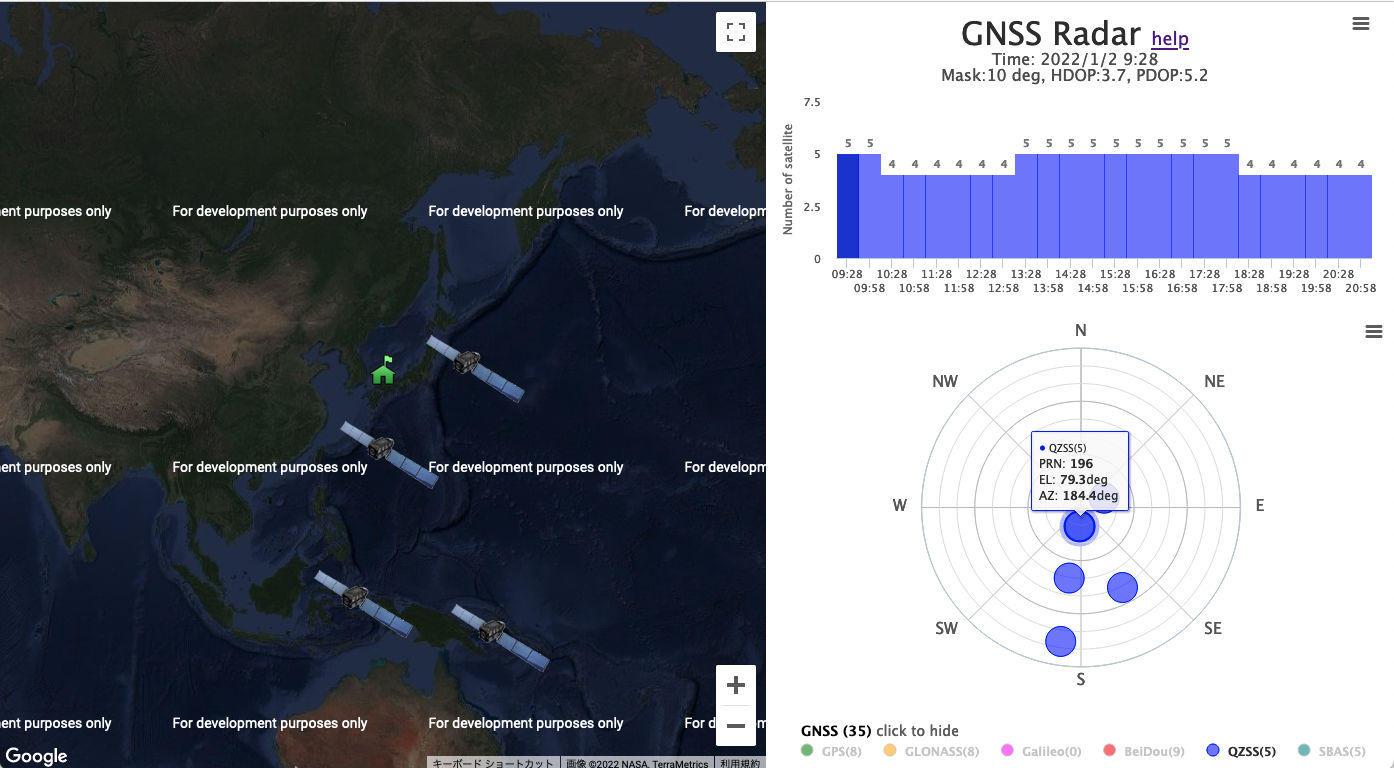
gnssradar/celestrack.txt
QZS-1 (MICHIBIKI-1)
1 37158U 10045A 21364.67751921 -.00000090 00000-0 00000-0 0 9998
2 37158 42.1625 135.7301 0757633 270.3981 80.4844 1.00272592 41390
QZS-2 (MICHIBIKI-2)
1 42738U 17028A 21364.60163928 -.00000146 00000-0 00000-0 0 9995
2 42738 42.0525 266.5517 0757002 269.5561 280.1703 1.00283494 16808
QZS-3 (MICHIBIKI-3)
1 42917U 17048A 21364.88786264 -.00000333 00000-0 00000-0 0 9998
2 42917 0.0672 155.5333 0002037 138.3521 252.3125 1.00270598 15929
QZS-4 (MICHIBIKI-4)
1 42965U 17062A 21364.88777542 -.00000321 00000-0 00000-0 0 9993
2 42965 40.8023 4.2848 0749963 271.6960 278.9637 1.00249791 15472
QZS-1R
1 49336U 21096A 21364.90784885 -.00000263 00000-0 00000-0 0 9990
2 49336 34.1421 104.4964 0760459 270.6847 183.2171 1.00265138 688
gnssradar/satlist.txt
5,193,37158U,QZS-1
5,194,42738U,QZS-2
5,195,42965U,QZS-4
5,196,49336U,QZS-1R
5,197,,
5,198,,
5,199,42917U,QZS-3
NovAtel OEM729
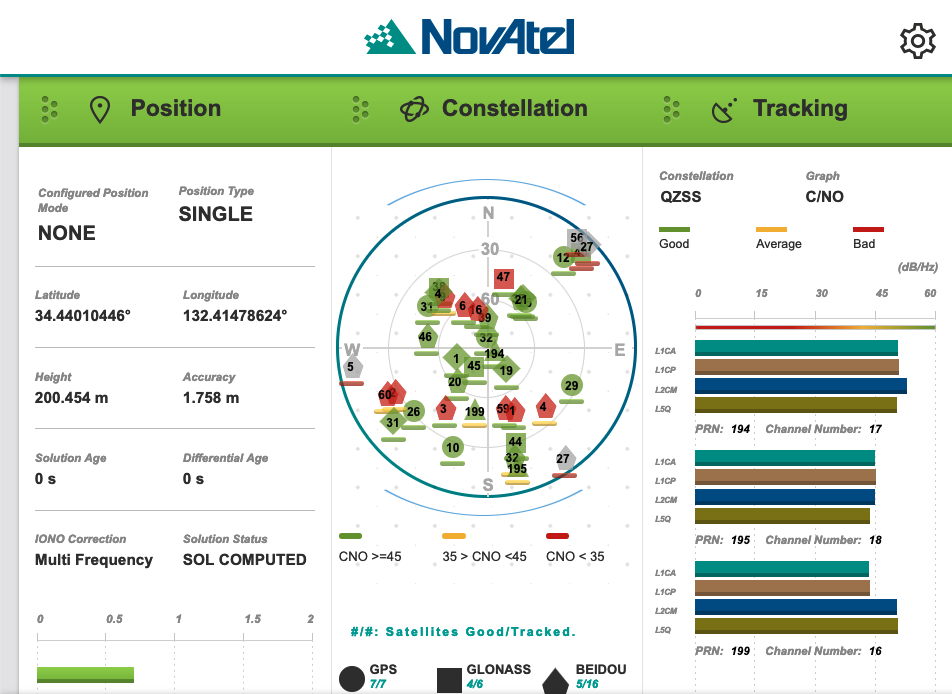
This is an all-in-view receiver that tries to process all the expected signals, but it seems unexpected for the QZS-1R.
On the management screen, I found the L6D signal of the QZS-1. Nevertheless, I couldn’t receive the L6D signal of QZS-2, QZS-3, QZS-4. Referring the third developmental issue of the human resources development project to accelerate satellite positioning technology, I found the modulation method is different between QZS-1 and other quasi-zenith satellites.
I would be happy if NovAtel could release new firmware for the current QZS signals.
u-blox ZED-F9P
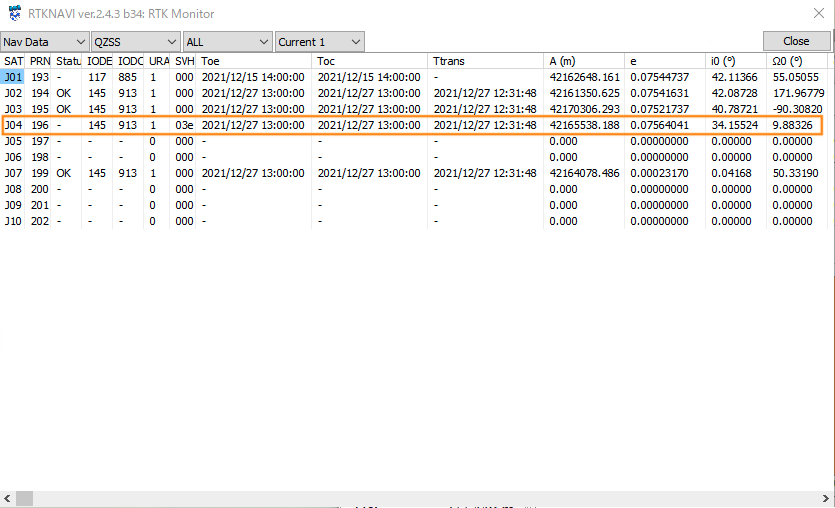
As already mentioned, the ZED-F9P receiver is capable of receiving the L1 C/A signal and the L1S. Wonderful.
u-blox NEO-M8T
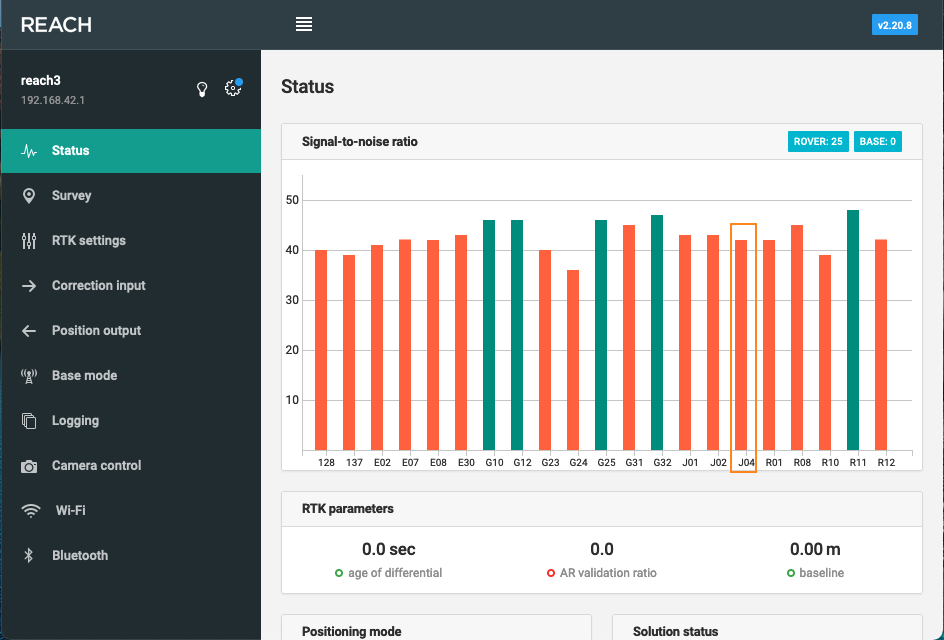
The management screen of Emlid Reach RTK, that uses u-blox NEO-M8T, indicated receiving QZS-1R signal denoted by J04. Wonderful.
I use an older version of the management software ReachView 2.20.8 for REACH RTK. In older versions, we can log in as root account with ssh (secure shell) and observe the great work of Emlid hackers. Connecting the TCP port number 2000 of the REACH RTK using u-center, we can also get the version and modifiy the configuration.
Sony Spresense
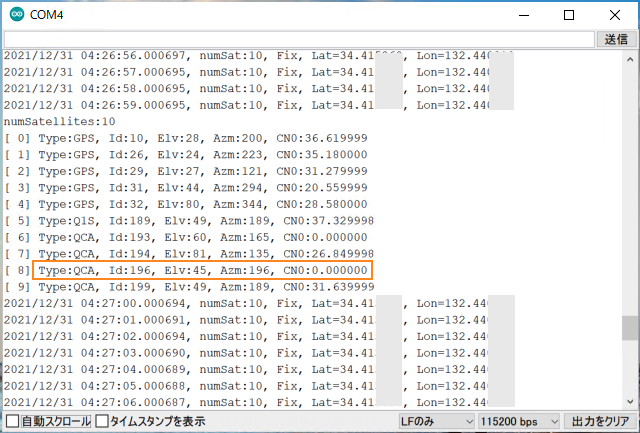
Great. There is a string QCA 196 representing the QZS-1R L1 C/A signal. For this observation, I used the sample sketch gnss.ino attached to Spresense’s Arduino IDE (integrated development environment) development software. For QZS-1R and QZS-1 (QCA 193), the C/N0 (carrier-to-noise density power ratio) is 0 dB Hz. I think it’s because both of them have the alert flag on.
KiwiSDR
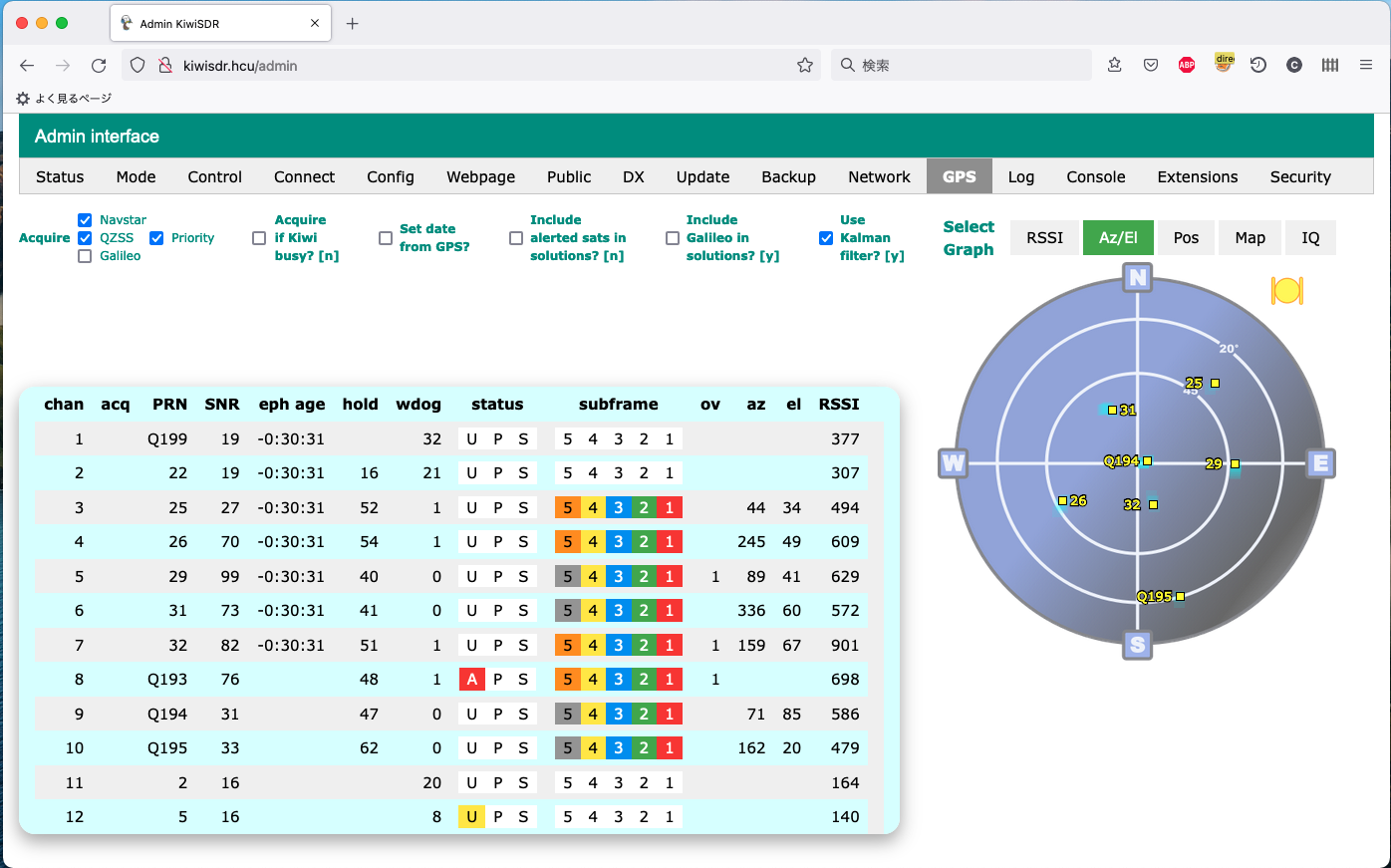
This is my Kiwi SDR management screen, but I couldn’t observe Q196 which represents QZS-1R. I checked the Source Code, and I found the PRN number of QZS-1R was commented out. It would be able to receive the QZS-1R’s L1 C/A signal if we remove the comment out. The alert flag was on for the QZS-1 (Q193) signal.
gps/sats.cpp
// QZSS (Japan) prn(saif) = 183++, prn(std) = 193++
// last checked: 9-Sep-2020
// sys.qzss.go.jp/dod/en/constellation.html [PNT L1 C/A entries]
{193, 339, 01050, QZSS}, // J01, QZS-1
{194, 208, 01607, QZSS}, // J02, QZS-2
{195, 711, 01747, QZSS}, // J04, QZS-4
// {196, 189, 01305, QZSS}, // (not scheduled until 2023)
// {197, 263, 00540, QZSS}, //
// {198, 537, 01363, QZSS}, //
{199, 663, 00727, QZSS}, // J03, QZS-3
// {200, 942, 00147},
// {201, 173, 01206},
// {202, 900, 01045},
(added on 2022-01-01)
After writing this article, I sent a pull request on GitHub to the KiwiSDR author. The merge was approved within 30 minutes after the request was sent. The QZS-1R is expected to be available on KiwiSDR in the near future. I would like to thank the author for the agile merge.
Allystar HD9310 option C
Raw data observation of the CLAS firmware with the Python code
195 2190 448539 37
194 2190 448539 41
199 2190 448539 41
--> prn 194 (snr 41)
195 2190 448540 37
194 2190 448540 42
199 2190 448540 42
--> prn 194 (snr 42)
195 2190 448541 37 RS
194 2190 448541 42
199 2190 448541 42
--> prn 194 (snr 42)
Raw data observation of the MADOCA firmware
205 2190 448509 38
204 2190 448509 42
209 2190 448509 42
--> prn 204 (snr 42)
205 2190 448510 37
204 2190 448510 42
209 2190 448510 42
--> prn 204 (snr 42)
205 2190 448511 37 RS
204 2190 448511 42
209 2190 448511 42
--> prn 204 (snr 42)
PRN 196 in CLAS and PRN 206 in MADOCA did not appear. I am looking forward to the QZS-1R test signal broadcast with the alert flag off on January 26, 2022, and the new firmware.
The number of L6D (CLAS) signal channels provided in the HD9310 is unknown. Beause I was able to decode all of the four QZS’s L6D signals, there are at least 4 channels. I am looking forward to the moment when I can observe all the five L6D signals of quasi-zenith satellites when the QZS-1 is in good health and the alert flag of the QZS-1R is turned off.
bynav C1-FS
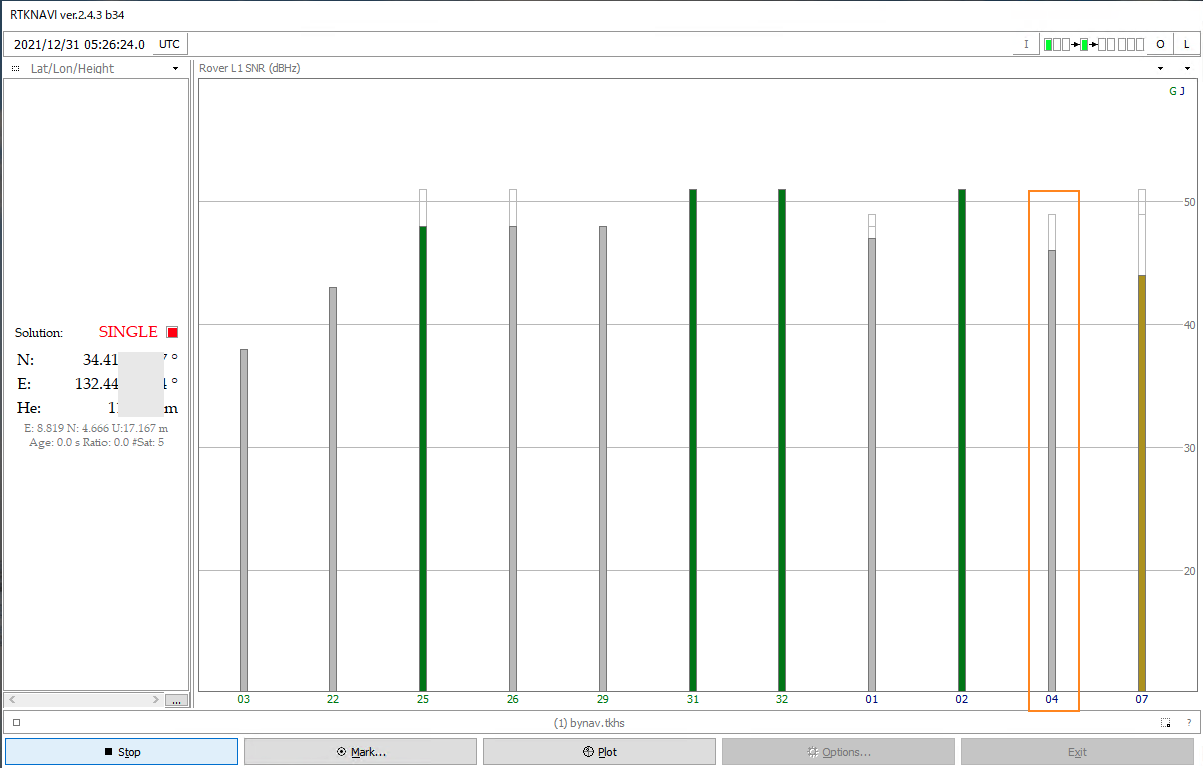
The raw data of C1-FS was observed in NovAtel OEM 7 mode of RTKNAVI with RTKLIB 2.4.3b34. I limited to show only for L1 C/A signals of GPS and QZS. The signals of QZS-1R (J04), QZS-1 (J01), QZS-2 (J02), and QZS-3 (J07) were received. Great.
Drogger VRSC
(added on 2022-01-02)
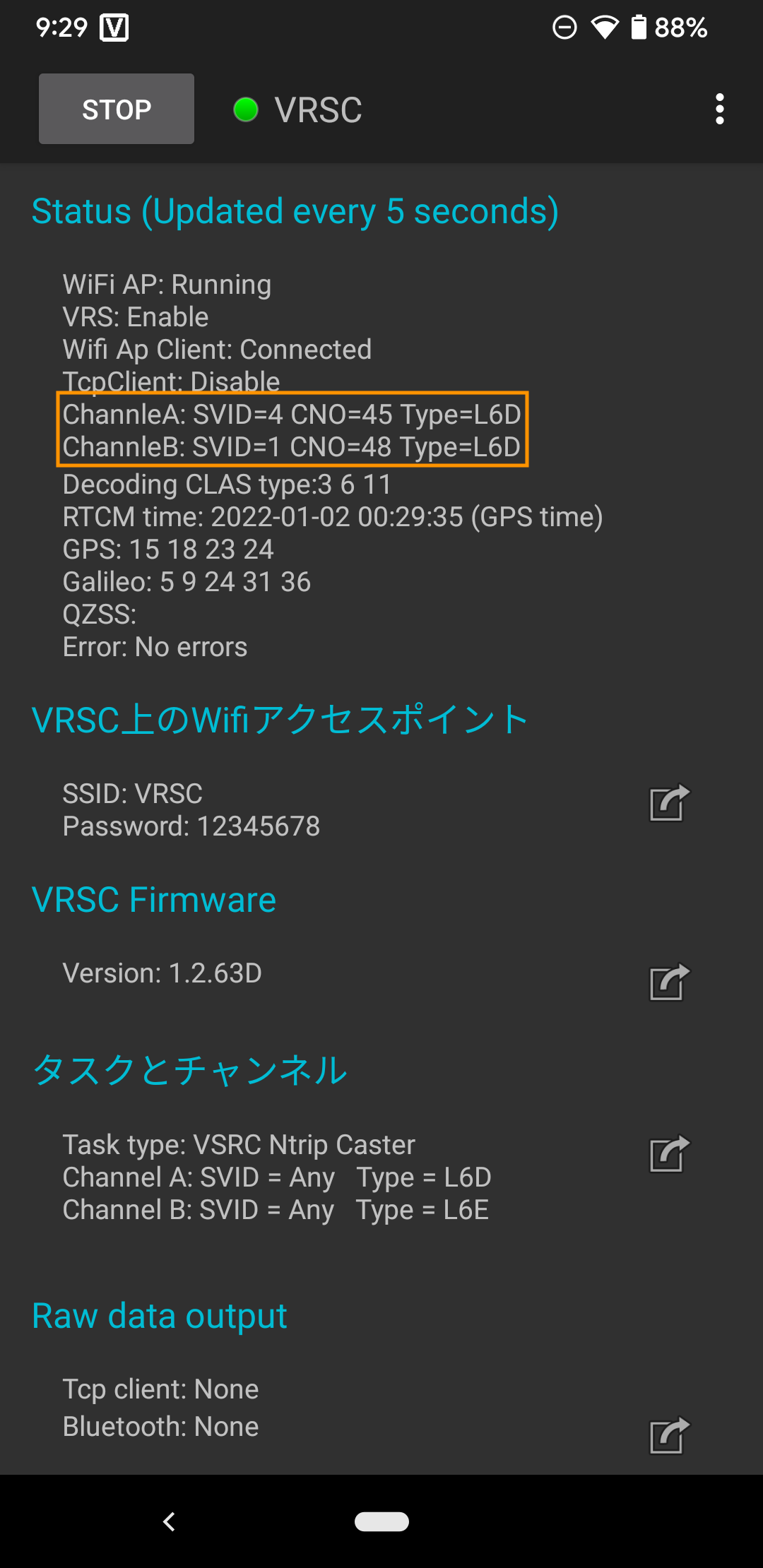
The BizStation’s Drogger VRSC is also capable of receiving the QZS signal. It is rumored that VRSC has u-blox NEO-D9C inside because the number of L6 reception channels is 2 and the ability of separately receiving L6D and L6E signals.
My VRSC receiver has captured the L6D signal (CLAS) from the QZS-1R, which is denoted by SVID 4. Wonderful. According to GNSS Radar mentioned above, the QZS-1R was almost at my zenith, and the QZS-1R was assigned to one of the two receiver channels.
Recently, I feel that the number of satellites to be augmented by CLAS has decreased.
Conclusion
For the QZS-1R, the next step test signal will be broadcast on January 26, 2022. This can be said to virtually be in operation. The operation of the disaster and crisis management report superposed on the L1S signal has also been changed accordingly. I am very happy and exciting to hear the announcement of the vigorous test signal broadcast.